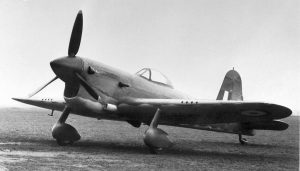Jacob Parakilas

Last week, the Russian Sukhoi design bureau unveiled the prototype of its new “Checkmate” light tactical fighter aircraft, to great interest from the aviation community. The interest stems not from the fact that the new Sukhoi represents any kind of novel capability – it is a budget-friendly competitor to expensive Western 4.5/5th generation aircraft – but because as development costs skyrocket, a new aircraft is a rare event these days.
That has not always been the case. In 1940, the United Kingdom found itself staring down the apparently unstoppable German war machine across the narrow English Channel. Having taken substantial losses of men and materiel in the Norwegian and French campaigns, the British government supplemented its conventional military procurement with emergency programs to quickly build basic, functional weapons: everything from small arms to armored vehicles to fixed defenses. The government also considered how to quickly build so-called “emergency fighters” to combat the Luftwaffe.
One particularly promising fighter design was the Miles M.20. Its structure was built from wood, its landing gear were fixed and streamlined to reduce mechanical complexity, and it used pre-existing components from other aircraft. For all that, the M.20 – which took a mere 65 days to go from design approval to first flight – demonstrated considerable performance. It was faster and more heavily armed than a Hawker Hurricane and substantially cheaper and easier to build than the Royal Air Force’s flagship Supermarine Spitfire, while having a much longer range than either.
In the event, the M.20 proved surplus to requirements. The Luftwaffe’s bombing campaign never seriously imperiled the RAF’s ability to produce enough of its existing types to win the Battle of Britain, so the emergency program never proceeded past two flying prototypes.
Still, there may be some lessons here. Obviously, there is no world war ongoing, so for the majority of countries there is no immediate need for emergency military hardware. Indeed, as I write this, the spread of Delta variant of COVID-19 and the immediate impacts of the climate crisis present a substantially greater threat to most people in most places than does conventional conflict between states.
That has not stopped rising levels of military spending globally – not only because of increased perceptions of insecurity and strategic competition, but because the cost of maintaining a technologically competitive military has ballooned. Modern tanks cost millions of dollars; fighter jets can approach a hundred million; and the largest warships can push into double-digit billions. Moreover, constructing these systems is a massively complex endeavor; for the highest-end systems, there may be only a single facility capable of building them, which puts hard limits on the extent to which production can be sped up, even in a national emergency.
That, in turn, means that the kinds of losses that might be incurred even in the opening stages of a major conventional war could be strategically debilitating, given the extended timeline for building up the kind of national capacity to mass-produce such complex systems (to say nothing of training additional personnel to maintain and operate them). Still, for both parochial and tactically sound reasons, industrialized militaries are generally unwilling to trade in their flagship systems and replace them with simpler ones, which could be more easily mass-produced in the event of emergency.
But some of the groundwork for at least supplementing a flagship force with the modern equivalent of emergency fighters can be laid in advance. Much as air forces did in the 1940s, governments could offer prototype development contracts, encouraging a wider range of companies to build innovative designs in small numbers for evaluation and training purposes and ramped up to mass production quickly in the event of urgent need. (This approach produced any number of innovative or ahead-of-their-time concepts throughout the 1940s and 1950s but fell by the wayside as the defense industry consolidated.)
And here, modern technology grants some advantages that the British engineers of 1940 could only dream of. Systems can be designed, tested, and refined in virtual or augmented reality environments to cut down on the cost of manufacturing, testing, and – inevitably – losing full-scale prototypes. 3D printing and other forms of additive or computer-aided manufacturing can allow the physical testing of many variations of a design in relatively short order.
Of course, a weapon by itself is of limited use if it is not accompanied by trained personnel, and here the contracting process would need to be accompanied by a doctrinal change. Some units would need to be assigned the simpler, less capable hardware; these units would form the training corps in the event that mass adoption of their equipment became necessary. Such a doctrinal change would take some time to institute and refine, which of course is an argument for starting before the need becomes urgent.
There is one further lesson from the M.20 that might be worth mentioning here. While the Spitfire and Hurricane were effective in defending Britain against Luftwaffe bombers, neither had the range to escort bombing missions over occupied Europe. As a result, Allied bombers took horrific losses until the arrival of large numbers of long-ranged P-51 Mustangs in 1944. The M.20 would have had sufficient range – perhaps not enough to change the course of the war but maybe enough to push Germany toward defeat a little bit sooner. A good enough basic design, after all, often proves its worth in ways that might surprise even the designer.
No comments:
Post a Comment